3DMet B00018 Related compounds IUPAC ID Methanal Molar mass 30.031 g/mol Melting point -92 °C | Appearance Colorless gas Formula CH2O Boiling point -19 °C Density 815 kg/m³ Soluble in Water | |
 | ||
Formaldehyde identification test organic compounds
Formaldehyde is a naturally occurring organic compound with the formula CH2O (H-CHO). It is the simplest of the aldehydes (R-CHO) and is also known by its systematic name methanal. The common name of this substance comes from its similarity and relation to formic acid.
Contents
- Formaldehyde identification test organic compounds
- Methanal or formaldehyde ch2o lewis dot structure
- Forms of formaldehyde
- Occurrence
- Interstellar formaldehyde
- History
- Industry
- Organic chemistry
- Examples of organic synthetic applications
- Industrial applications
- Disinfectant and biocide
- Tissue fixative and embalming agent
- Drug testing
- Photography
- Safety
- International bans
- Hurricanes Katrina and Rita
- Iowa floods of 2008
- Contaminant in food
- References
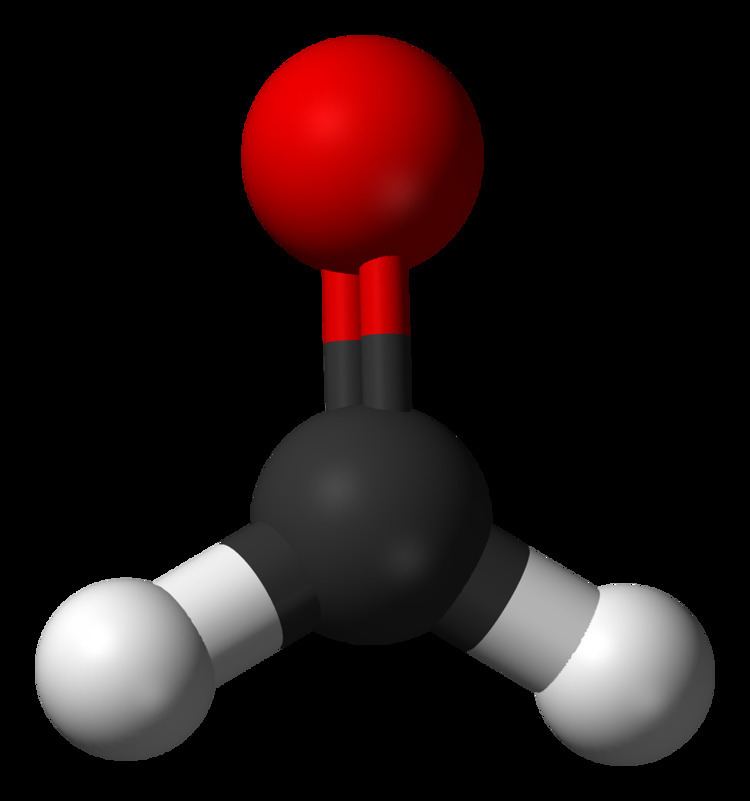
Formaldehyde is an important precursor to many other materials and chemical compounds. In 1996, the installed capacity for the production of formaldehyde was estimated to be 8.7 million tons per year. It is mainly used in the production of industrial resins, e.g., for particle board and coatings.

In view of its widespread use, toxicity, and volatility, formaldehyde poses a significant danger to human health. In 2011, the US National Toxicology Program described formaldehyde as "known to be a human carcinogen".
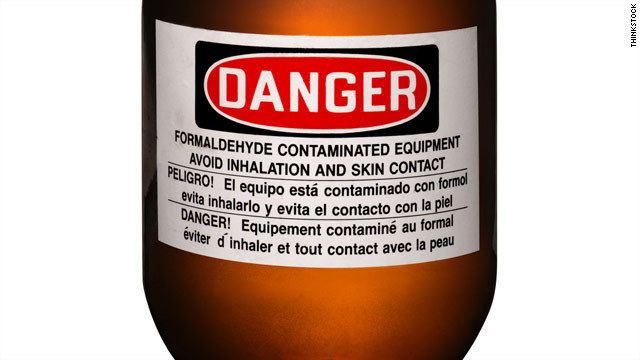
Methanal or formaldehyde ch2o lewis dot structure
Forms of formaldehyde

Formaldehyde is more complicated than many simple carbon compounds in that it adopts several different forms. As a gas, formaldehyde is colorless and has a characteristic pungent, irritating odor. Upon condensation, the gas converts to various other forms of formaldehyde (with different chemical formulas) that are of more practical value. One important derivative is the cyclic trimer metaformaldehyde or 1,3,5-trioxane with the formula (CH2O)3. There is also a linear polymer called paraformaldehyde. These compounds have similar chemical properties and are often used interchangeably.

When dissolved in water, formaldehyde also forms a hydrate, methanediol, with the formula H2C(OH)2. This compound also exists in equilibrium with various oligomers (short polymers), depending on the concentration and temperature. A saturated water solution, of about 40% formaldehyde by volume or 37% by mass, is called "100% formalin". A small amount of stabilizer, such as methanol, is usually added to suppress oxidation and polymerization. A typical commercial grade formalin may contain 10–12% methanol in addition to various metallic impurities. The name was long ago genericized from an old trade name "Formalin".
Occurrence
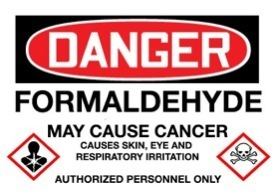
Processes in the upper atmosphere contribute up to 90% of the total formaldehyde in the environment. Formaldehyde is an intermediate in the oxidation (or combustion) of methane, as well as of other carbon compounds, e.g. in forest fires, automobile exhaust, and tobacco smoke. When produced in the atmosphere by the action of sunlight and oxygen on atmospheric methane and other hydrocarbons, it becomes part of smog. Formaldehyde has also been detected in outer space (see below).
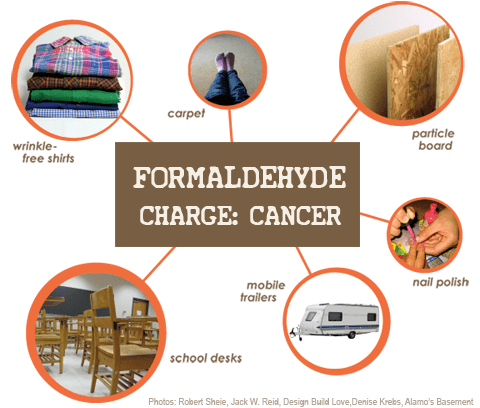
Formaldehyde and its adducts are ubiquitous in living organisms. It is formed in the metabolism of endogenous amino acids and is found in the bloodstream of humans and other primates at concentrations of approximately 0.1 millimolar. Experiments in which animals are exposed to an atmosphere containing isotopically labeled formaldehyde have demonstrated that even in deliberately exposed animals, the majority of formaldehyde-DNA adducts found in non-respiratory tissues are derived from endogenously produced formaldehyde.
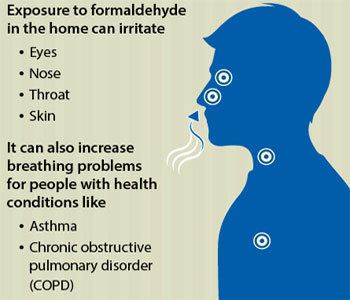
Formaldehyde does not accumulate in the environment, because it is broken down within a few hours by sunlight or by bacteria present in soil or water. Humans metabolize formaldehyde quickly, so it does not accumulate, converting it to formic acid in the body.
Interstellar formaldehyde

Formaldehyde was the first polyatomic organic molecule detected in the interstellar medium. Since its initial detection in 1969, it has been observed in many regions of the galaxy. Because of the widespread interest in interstellar formaldehyde, it has recently been extensively studied, yielding new extragalactic sources. A proposed mechanism for the formation is the hydrogenation of CO ice, shown below.
H + CO → HCOHCO + H → CH2O (rate constant=9.2×10−3 s−1)Formaldehyde appears to be a useful probe for astrochemists due to its low reactivity in the gas phase and to the fact that the 110←111 and 211←212 K-doublet transitions are rather clear.
On 11 August 2014, astronomers released studies, using the Atacama Large Millimeter/Submillimeter Array (ALMA) for the first time, that detailed the distribution of HCN, HNC, H2CO, and dust inside the comae of comets C/2012 F6 (Lemmon) and C/2012 S1 (ISON).
History
Formaldehyde was first reported in 1859 by the Russian chemist Aleksandr Butlerov (1828–86) and was conclusively identified in 1869 by August Wilhelm von Hofmann.
Industry
Formaldehyde is produced industrially by the catalytic oxidation of methanol. The most common catalysts are silver metal or a mixture of an iron and molybdenum or vanadium oxides. In the commonly used formox process, methanol and oxygen react at ca. 250–400 °C in presence of iron oxide in combination with molybdenum and/or vanadium to produce formaldehyde according to the chemical equation:
2 CH3OH + O2 → 2 CH2O + 2 H2OThe silver-based catalyst usually operates at a higher temperature, about 650 °C. Two chemical reactions on it simultaneously produce formaldehyde: that shown above and the dehydrogenation reaction:
CH3OH → CH2O + H2In principle, formaldehyde could be generated by oxidation of methane, but this route is not industrially viable because the methanol is more easily oxidized than methane.
Organic chemistry
Formaldehyde is a building block in the synthesis of many other compounds of specialised and industrial significance. It exhibits most of the chemical properties of other aldehydes but is more reactive. For example, it is more readily oxidized by atmospheric oxygen into formic acid (formic acid is found in ppm levels in commercial formaldehyde). Formaldehyde is a good electrophile, participating in electrophilic aromatic substitution reactions with aromatic compounds, and can undergo electrophilic addition reactions with alkenes and aromatics. Formaldehyde undergoes a Cannizzaro reaction in the presence of basic catalysts to produce formic acid and methanol.
Examples of organic synthetic applications
Condensation with acetaldehyde affords pentaerythritol, a chemical necessary in synthesizing PETN, a high explosive. Condensation with phenols gives phenol-formaldehyde resins. With 4-substituted phenols one obtains calixarenes.
When combined with hydrogen sulfide, it forms trithiane.
3CH2O + 3H2S → (CH2S)3 + 3H2OFormaldehyde can be reduced to methylamine via reductive amination. Methylamine can then be used in other synthetic processes using reductive amination to yield secondary amines.
It is first reacted with ammonia to form an imine and water.
CH2O + NH3 → H2C=NH +H2OThen this is reduced using LiAlH4 via an Sn2 reaction or by catalytic hydrogenation to produce the amine.
H2C=N-H + LiAlH4 → H3CNH2H2C=N-H + H2 → H3CNH2Industrial applications
Formaldehyde is a common precursor to more complex compounds and materials. In approximate order of decreasing consumption, products generated from formaldehyde include urea formaldehyde resin, melamine resin, phenol formaldehyde resin, polyoxymethylene plastics, 1,4-butanediol, and methylene diphenyl diisocyanate. The textile industry uses formaldehyde-based resins as finishers to make fabrics crease-resistant. Formaldehyde-based materials are key to the manufacture of automobiles, and used to make components for the transmission, electrical system, engine block, door panels, axles and brake shoes. The value of sales of formaldehyde and derivative products was over $145 billion in 2003, about 1.2% of the gross domestic product (GDP) of the United States and Canada. Including indirect employment, over 4 million people work in the formaldehyde industry across approximately 11,900 plants in the U.S. and Canada.
When treated with phenol, urea, or melamine, formaldehyde produces, respectively, hard thermoset phenol formaldehyde resin, urea formaldehyde resin, and melamine resin. These polymers are common permanent adhesives used in plywood and carpeting. It is used as the wet-strength resin added to sanitary paper products such as (listed in increasing concentrations injected into the paper machine headstock chest) facial tissue, table napkins, and roll towels. They are also foamed to make insulation, or cast into moulded products. Production of formaldehyde resins accounts for more than half of formaldehyde consumption.
Formaldehyde is also a precursor to polyfunctional alcohols such as pentaerythritol, which is used to make paints and explosives. Other formaldehyde derivatives include methylene diphenyl diisocyanate, an important component in polyurethane paints and foams, and hexamine, which is used in phenol-formaldehyde resins as well as the explosive RDX. Formaldehyde has been found as a contaminant in several bath products, at levels from 54–610 ppm: it is thought to arise from the breakdown of preservatives in the products, most frequently diazolidinyl urea. Since 2006, formaldehyde (methylene glycol) is also used in hair smoothing treatments in order to straighten wavy/curly hair and make hair less prone to frizz under high humid weather. OSHA Oregon has reported these treatments as unsafe for human health.
Disinfectant and biocide
An aqueous solution of formaldehyde can be useful as a disinfectant as it kills most bacteria and fungi (including their spores). Formaldehyde solutions are applied topically in medicine to dry the skin, such as in the treatment of warts. Many aquarists use formaldehyde as a treatment for the parasites Ichthyophthirius multifiliis and Cryptocaryon irritans.
Formaldehyde is used to inactivate bacterial products for toxoid vaccines (vaccines that use an inactive bacterial toxin to produce immunity). It is also used to kill unwanted viruses and bacteria that might contaminate the vaccine during production. Urinary tract infections are also often treated using a derivative of formaldehyde (methenamine), a method often chosen because it prevents overuse of antibiotics and the resultant development of bacterial resistance to them. In an acid environment, methenamine is converted in the kidneys to formaldehyde, which then has an antibacterial effect in the urinary tract. Some topical creams, cosmetics, and personal hygiene products contain derivatives of formaldehyde as the active ingredients that prevent the growth of potentially harmful bacteria.
Formaldehyde is also approved for use in the manufacture of animal feeds in the US. It is an antimicrobial agent used to maintain complete animal feeds or feed ingredients Salmonella negative for up to 21 days.
Tissue fixative and embalming agent
Formaldehyde preserves or fixes tissue or cells by a mixture of reversible (short exposure time and low temperatures) and irreversible (long exposure time and higher temperatures) cross-linking of primary amino groups in proteins with other nearby nitrogen atoms in protein or DNA through a -CH2- linkage. This is exploited in ChIP-on-chip or ChIP-sequencing genomics experiments, where DNA-binding proteins are cross-linked to their cognate binding sites on the chromosome and analyzed to determine what genes are regulated by the proteins. Formaldehyde is also used as a denaturing agent in RNA gel electrophoresis, preventing RNA from forming secondary structures. A solution of 4% formaldehyde fixes pathology tissue specimens at about one mm per hour at room temperature.
Formaldehyde solutions are used as a fixative for microscopy and histology because of formaldehyde's ability to perform the Mannich reaction, although the percentage formaldehyde used may vary based on the method of analysis. Additionally, the methanol used to stabilize formaldehyde may interfere with the ability to properly fix tissue or cells, and therefore commercial formaldehyde preparations are available that are packaged in glass ampules under an inert gas to prevent the use of contaminating methanol for stabilization. Formaldehyde-based solutions are also used in embalming to disinfect and temporarily preserve human and animal remains. It is the ability of formaldehyde to fix the tissue that produces the tell-tale firmness of flesh in an embalmed body. In post mortem examinations a procedure known as the "sink test" involves placing the lungs of an animal in an aqueous solution of formaldehyde; if the lungs float it suggests the animal was probably breathing or able to breathe at the time of death.
Although formaldehyde solutions are commonly used as a biological preserving medium, usually for smaller specimens, it delays, but does not prevent, decay. This method of fixation does not preserve nucleic acids, thus preventing, for example, genetic analysis of the first discovered Dendrogramma specimens.
Several European countries restrict the use of formaldehyde, including the import of formaldehyde-treated products and embalming. Starting September 2007, the European Union banned the use of formaldehyde due to its carcinogenic properties as a biocide (including embalming) under the Biocidal Products Directive (98/8/EC). Countries with a strong tradition of embalming corpses, such as Ireland and other colder-weather countries, have raised concerns. Despite reports to the contrary, no decision on the inclusion of formaldehyde on Annex I of the Biocidal Products Directive for product-type 22 (embalming and taxidermist fluids) had been made as of September 2009.
Drug testing
Formaldehyde, along with 18 M (concentrated) sulfuric acid makes Marquis reagent which can be used to identify alkaloids and other compounds.
Photography
In photography, formaldehyde is used in low concentrations for process C-41 (color negative film) stabilizer in the final wash step, as well as in the process E-6 pre-bleach step, to make it unnecessary in the final wash.
Safety
Formaldehyde is highly toxic to all animals, regardless of method of intake. Ingestion of 30 mL (1 oz.) of a solution containing 37% formaldehyde has been reported to cause death in an adult human. Water solution of formaldehyde is very corrosive and its ingestion can cause severe injury to the upper gastrointestinal tract.
Occupational exposure to formaldehyde by inhalation is mainly from three types of sources: thermal or chemical decomposition of formaldehyde-based resins, formaldehyde emission from aqueous solutions (for example, embalming fluids), and the production of formaldehyde resulting from the combustion of a variety of organic compounds (for example, exhaust gases). Formaldehyde can be toxic, allergenic, and carcinogenic. Because formaldehyde resins are used in many construction materials it is one of the more common indoor air pollutants. At concentrations above 0.1 ppm in air formaldehyde can irritate the eyes and mucous membranes, resulting in watery eyes. Formaldehyde inhaled at this concentration may cause headaches, a burning sensation in the throat, and difficulty breathing, and can trigger or aggravate asthma symptoms.
A 1988 Canadian study of houses with urea-formaldehyde foam insulation found that formaldehyde levels as low as 0.046 ppm were positively correlated with eye and nasal irritation. A recent review of studies has shown a strong association between exposure to formaldehyde and the development of childhood asthma. The primary exposure concern is for the workers in the industries producing or using formaldehyde.
The formaldehyde theory of carcinogenesis was proposed in 1978. In 1987 the U.S. EPA classified it as a probable human carcinogen, and after more studies the WHO International Agency for Research on Cancer (IARC) in 1995 also classified it as a probable human carcinogen. Further information and evaluation of all known data led the IARC to reclassify formaldehyde as a known human carcinogen associated with nasal sinus cancer and nasopharyngeal cancer. Recent studies have also shown a positive correlation between exposure to formaldehyde and the development of leukemia, particularly myeloid leukemia. Nasopharyngeal and sinonasal cancers are relatively rare, with a combined annual incidence in the United States of < 4,000 cases. About 25,000 cases of myeloid leukemia occur in the United States each year. Workplace exposure to inhaled chemicals is among the most important risk factors for sinonasal cancers. Professionals exposed to formaldehyde in their occupation, such as funeral industry workers and embalmers, showed an increased risk of leukemia and brain cancer compared with the general population. Other factors are important in determining individual risk for the development of leukemia or nasopharyngeal cancer.
In the residential environment, formaldehyde exposure comes from a number of different routes; formaldehyde can off-gas from wood products, such as plywood or particle board, but it is produced by paints, varnishes, floor finishes, and cigarette smoking as well. In July 2016, the EPA released a prepublication version of its final rule on Formaldehyde Emission Standards for Composite Wood Products. These new rules will impact manufacturers, importers, distributors, and retailers of products containing composite wood, including fiberboard, particleboard and various laminated products, who will need to comply with more stringent record-keeping and labeling requirements.
The United States Environmental Protection Agency (EPA) allows no more than 0.016 ppm formaldehyde in the air in new buildings constructed for that agency. A U.S. Environmental Protection Agency study found a new home measured 0.076 ppm when brand new and 0.045 ppm after 30 days. The Federal Emergency Management Agency (FEMA) has also announced limits on the formaldehyde levels in trailers purchased by that agency. The EPA recommends the use of "exterior-grade" pressed-wood products with phenol instead of urea resin to limit formaldehyde exposure, since pressed-wood products containing formaldehyde resins are often a significant source of formaldehyde in homes.
For most people, irritation from formaldehyde is temporary and reversible, though formaldehyde can cause allergies and is part of the standard patch test series. In 2005–06, it was the seventh-most-prevalent allergen in patch tests (9.0%). People with formaldehyde allergy are advised to avoid formaldehyde releasers as well (e.g., Quaternium-15, imidazolidinyl urea, and diazolidinyl urea). People who suffer allergic reactions to formaldehyde tend to display lesions on the skin in the areas that have had direct contact with the substance, such as the neck or thighs (often due to formaldehyde released from permanent press finished clothing) or dermatitis on the face (typically from cosmetics). Formaldehyde has been banned in cosmetics in both Sweden and Japan. The eyes are most sensitive to formaldehyde exposure: The lowest level at which many people can begin to smell formaldehyde is about 0.05 ppm and the highest level is 1 ppm. The maximum concentration value at the workplace is 0.3 ppm. In controlled chamber studies, individuals begin to sense eye irritation at about 0.5 ppm; 5 to 20 percent report eye irritation at 0.5 to 1 ppm; and greater certainty for sensory irritation occurred at 1 ppm and above. While some agencies have used a level as low as 0.1 ppm as a threshold for irritation, the expert panel found that a level of 0.3 ppm would protect against nearly all irritation. In fact, the expert panel found that a level of 1.0 ppm would avoid eye irritation—the most sensitive endpoint—in 75–95% of all people exposed.
Formaldehyde levels in building environments are affected by a number of factors. These include the potency of formaldehyde-emitting products present, the ratio of the surface area of emitting materials to volume of space, environmental factors, product age, interactions with other materials, and ventilation condition. Formaldehyde emits from a variety of construction materials, furnishings, and consumer products. The three products that emit the highest concentrations are medium density fiberboard, hardwood plywood, and particle board. Environmental factors such as temperature and relative humidity can elevate levels because formaldehyde has a high vapor pressure. Formaldehyde levels from building materials are the highest when a building first opens because materials would have less time to off-gas. Formaldehyde levels decrease over time as the sources suppress.
Formaldehyde levels in air can be sampled and tested in several ways, including impinger, treated sorbent, and passive monitors. The National Institute for Occupational Safety and Health (NIOSH) has measurement methods numbered 2016, 2541, 3500, and 3800.
Studies on the interactions between formaldehyde and proteins at the molecular level have been reported on the effects of the body’s carrier protein, serum albumin. The binding of formaldehyde loosens the skeletal structure of albumin and exposure of aromatic ring amino acids in the internal hydrophobic region. Symptoms may affect personal awareness, making one feel tired or fatigued.
Formaldehyde inhalation has also shown to cause oxidative stress and inflammation in animals. Mice studied over an exposure to a high dose of formaldehyde (3ppm), showed increased NO−
3 levels in plasma. This result suggests that FA inhalation either decreased NO production or increased NO scavenging, which may be an anti-stress mechanism in the body. Formaldehyde inhalation changes the sensitivity of immune system, which influences oxidative stress.
In June 2011, the twelfth edition of the National Toxicology Program (NTP) Report on Carcinogens (RoC) changed the listing status of formaldehyde from "reasonably anticipated to be a human carcinogen" to "known to be a human carcinogen". Concurrently, a National Academy of Sciences (NAS) committee was convened and issued an independent review of the draft United States Environmental Protection Agency IRIS assessment of formaldehyde, providing a comprehensive health effects assessment and quantitative estimates of human risks of adverse effects.
International bans
There are several web articles claiming that formaldehyde has been banned from manufacture or import into the European Union (EU) under REACH (Registration, Evaluation, Authorization, and restriction of Chemical substances) legislation. This appears to be misinformation, as official EU chemical databases contradict these claims as of February 19, 2010. This misconception has gained some ground. Formaldehyde is not listed in the Annex I of Regulation (EC) No 689/2008 (export and import of dangerous chemicals regulation), nor on a priority list for risk assessment. However, formaldehyde is banned from use in certain applications (preservatives for liquid-cooling and processing systems, slimicides, metalworking-fluid preservatives, and antifouling products) under the Biocidal Products Directive. In the EU, the maximum allowed concentration of formaldehyde in finished products is 0.2%, and any product that exceeds 0.05% has to include a warning that the product contains formaldehyde.
In the United States, a bill was passed in Congress on July 7, 2010, regarding the use of formaldehyde in hardwood plywood, particle board, and medium density fiberboard. The bill limited the allowable amount of formaldehyde emissions from these wood products to .09 ppm, a standard which companies were required to meet by January 2013. Formaldehyde was declared a toxic substance by the 1999 Canadian Environmental Protection Act.
Hurricanes Katrina and Rita
In the U.S. the Federal Emergency Management Agency (FEMA) provided travel trailers, recreational park trailers and manufactured homes starting in 2006 for habitation by residents of the U.S. gulf coast displaced by Hurricane Katrina and Hurricane Rita. Some of the people who moved into the FEMA trailers complained of breathing difficulties, nosebleeds, and persistent headaches. Formaldehyde-catalyzed resins were used in the production of these homes.
The United States Centers For Disease Control and Prevention (CDC) performed indoor air quality testing for formaldehyde in some of the units. On February 14, 2008, the CDC announced that potentially hazardous levels of formaldehyde were found in many of the travel trailers and manufactured homes provided by the agency. The CDC's preliminary evaluation of a scientifically established random sample of 519 travel trailers and manufactured homes tested between December 21, 2007, and January 23, 2008 (2+ years after manufacture), showed average levels of formaldehyde in all units of about 0.077 parts per million (ppm). Long-term exposure to levels in this range can be linked to an increased risk of cancer and, at levels above this range, there can also be a risk of respiratory illness. These levels are higher than expected in indoor air, where levels are commonly in the range of 0.01–0.02 ppm, and are higher than the Agency for Toxic Substance Disease Registry (ATSDR, division of the CDC) Minimal Risk Level (MRL) of 0.008 ppm. Levels measured ranged from 0.003 ppm to 0.59 ppm.
FEMA, which requested the testing by the CDC, said it would work aggressively to relocate all residents of the temporary housing as soon as possible. Lawsuits were filed against FEMA trailer manufacturers as a result of the exposures. As of 2012, U.S. District Judge Kurt D. Engelhardt of New Orleans approved a $42.6 million class-action lawsuit settlement for the plaintiffs, who included roughly 55,000 residents of Louisiana, Mississippi, Alabama and Texas. The defendants included two dozen manufacturers who built mobile homes for the Federal Emergency Management Agency (FEMA), including Gulf Stream Coach Inc., Forest River Inc., Vanguard LLC and Monaco Coach Corp. A separate $5.1 million settlement dealt with claims against FEMA contractors including Shaw Environmental Inc., Bechtel Corp., Fluor Enterprises Inc. and CH2M Hill Constructors Inc., who were responsible for installing and maintaining the units.
Iowa floods of 2008
Also in the U.S., problems arose in trailers again provided by FEMA to residents displaced by the Iowa floods of 2008. Several months after moving to the trailers, occupants reported violent coughing, headaches, as well as asthma, bronchitis, and other problems. Tests showed that in some trailers, levels of formaldehyde exceeded the limits recommended by the U.S. Environmental Protection Agency and American Lung Association. The associated publicity has resulted in additional testing to begin in November.
Contaminant in food
Scandals have broken in both the 2005 Indonesia food scare and 2007 Vietnam food scare regarding the addition of formaldehyde to foods to extend shelf life. In 2011, after a four-year absence, Indonesian authorities found foods with formaldehyde being sold in markets in a number of regions across the country. Besides using formaldehyde, they also used borax, but not in combination. In August 2011, at least at two Carrefour supermarkets, the Central Jakarta Livestock and Fishery Sub-Department found a sweet glutinous rice drink (cendol) contained 10 parts per million of formaldehyde. In 2014, the owner of two noodle factories in Bogor, Indonesia; was arrested for using formaldehyde in noodles. 50 kg of formaldehyde was confiscated. Foods known to be contaminated include noodles, salted fish, and tofu; chicken and beer are also rumored to be contaminated. In some places, such as China, formaldehyde is still used illegally as a preservative in foods, which exposes people to formaldehyde ingestion. In humans, the ingestion of formaldehyde has been shown to cause vomiting, abdominal pain, dizziness, and in extreme cases can cause death. Testing for formaldehyde is by blood and/or urine by gas chromatography-mass spectrometry. Other methods include infrared detection, gas detector tubes, etc., of which HPLC is the most sensitive. In the early 1900s, it was frequently added by US milk plants to milk bottles as a method of pasteurization due to the lack of knowledge regarding formaldehyde's toxicity.
In 2011 in Nakhon Ratchasima, Thailand, truckloads of rotten chicken were exposed to formaldehyde in which "a large network," including 11 slaughterhouses run by a criminal gang, were implicated. In 2012, 1 billion rupiah (almost USD100,000) of fish imported from Pakistan to Batam, Indonesia, were found laced with formaldehyde.
Formalin use in foods is a crucial problem in Bangladesh currently. Local stores and supermarkets often sell fruits, fishes, and vegetables that have been treated with formalin to keep them fresh. However, in 2015, a Formalin Control Bill was passed in the Parliament of Bangladesh with a provision of life-term imprisonment as the maximum punishment and in addition 2,000,000 BDT as fine but not less than 500,000 BDT for importing, production or hoarding of formalin without license.
